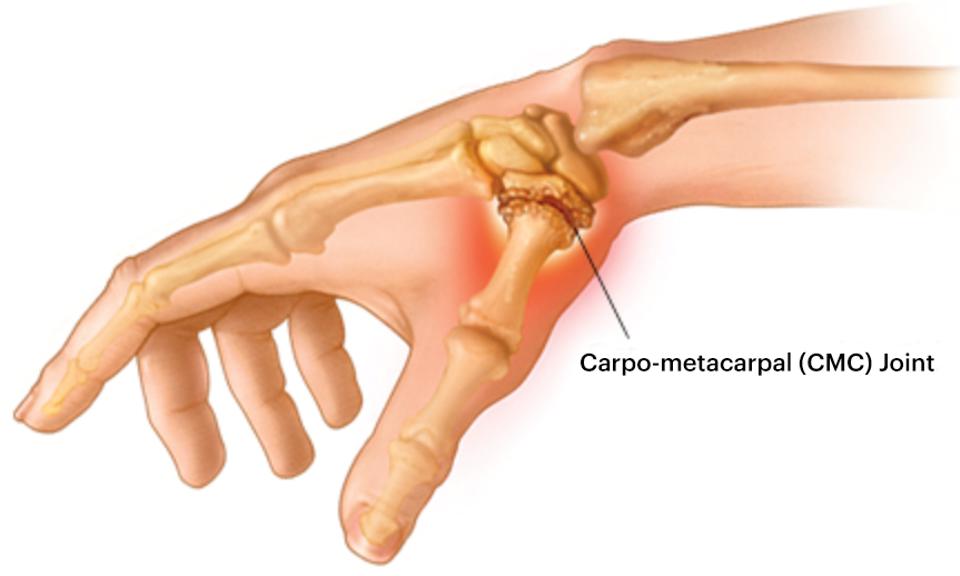What is base of thumb arthritis?
The joint at the base of the thumb, between the metacarpal and trapezium bones, becomes arthritic as people age. It is osteoarthritis, which is caused by loss of the smooth cartilage surface covering the ends of the bones in the joints. The cartilage becomes thin and rough, and the bone ends can rub together. Osteoarthritis can develop at any age, but usually appears after the age of 45. It may run in families, and it sometimes follows a fracture involving the joint many years before. Arthritis of the basal joint of the thumb is common in women and less common in men.

X-rays show it is present in about 60% of women over the age of 60, but many people with arthritis of this joint have no significant pain.
What are the symptoms?
- Pain at the base of the thumb, aggravated by thumb use.
- Tenderness if you press on the base of the thumb.
- Difficulty with tasks such as opening jars or turning a key in the lock.
- Stiffness of the thumb and some loss of ability to open the thumb away from the hand.
- In advanced cases, there is a bump at the base of the thumb and the middle thumb joint may hyperextend, giving a zigzag appearance.
What is the Natural History?
The natural history of this condition is often that the pain ‘burns out’ with time. The arthritis itself is always present, and never improves, but the symptoms from it often go away completely over the course of a few years. All very elderly patients have his condition, but few complain of ongoing pain. Thumb based arthritis rarely does any significant harm, and likewise, using the thumb normally in the presence of pain does not do any harm to the joint.
How can it be treated?
It is important to note that treatment is not necessary for the arthritis itself, but may help with pain control. Secondly, all interventions given by a doctor, nurse or physiotherapist carry a small risk, and although this is rarely a major problem, a tiny proportion of patients have life changing complications from steroid injections or surgery.
The options for pain relief include:
- Avoiding activities that cause pain, if possible.
- Painkillers can be useful, but not everyone finds
them helpful. - Using a splint to support the thumb and wrist. Rigid splints (metal or plastic) are effective but make thumb use difficult. A flexible neoprene rubber support is more practicable, and there are some rigid splints on the market which allow normal wrist movement and may make it easier to work whilst wearing the splint. (https://www.push.eu/products/hand-braces/push-ortho-thumb-brace-cmc)
- Steroid injection improves pain in many cases, though the effect wears off over time. The risks of injection are small, but it very occasionally causes some thinning or colour change in the skin at the site of injection. In addition, there is a tiny risk of serious complications such as infection, tendon rupture or chronic regional pain syndrome. Improvement may occur within a few days of injection, but often takes several weeks to be effective.
- Surgery is a last resort, as the symptoms often stabilise over the long term and can be controlled by the non-surgical treatments above.
There are 2 main operations offered for this condition:
- Trapeziectomy, or removal of the trapezium is the most commonly performed operation. This has a good track record for relieving pain, however the thumb is considerably weaker and less stable following this operation, so the decision to operate involves weighing up whether the pain relief obtained is worth the sacrifice of function.
- Fusion of the Joint. Fusing the joint can also provide good pain relief in a small group of patients who are generally young, manual workers. The results are far less predictable, with a relatively high complication rate. Fusing the joint restricts the mobility of the thumb significantly, so with this operation the scales have pain relief on one side and loss of movement as the main drawback.
Please consider the treatment options described and if you wish to discuss further or seek more information or advice, please contact the hand helpline on: 01592 643355 Ext 22441 or e-mail Orthopaedic hand service – Fife.fifehandservice@nhs.scot
We will aim to return your call/respond to e-mail within 72 hours.
Accessible formats
If you require this information in a community language or alternative format such as Braille, audio, large print, BSL, or Easy Read, please contact the Equality and Human Rights Team at: email: fife.EqualityandHumanRights@nhs.scot or phone 01592 729130. For people with a hearing or verbal impairment you can also contact the team through the NHS Fife SMS text service number on 07805800005.
